When renovating or building your dream home, nothing should be overlooked, even the ceiling is a topic of discussion at some point. And when you talk about ceilings, people think drywall is the only ceiling type available to them, which is wrong. There are different types of ceilings you can use for your home and each of them has a unique impact on the ambiance of your home.
Aside from the appearance, a ceiling also provides thermal, moisture, and sound insulation. What’s more? They hide wires, add to the home’s curb appeal, and regulate the air. From their striking patterns to their magnificent texture, here are some of the best ceiling types for your home along with their pros and cons.
Different types of ceilings for both commercial and residential buildings by design
1. Conventional Ceiling
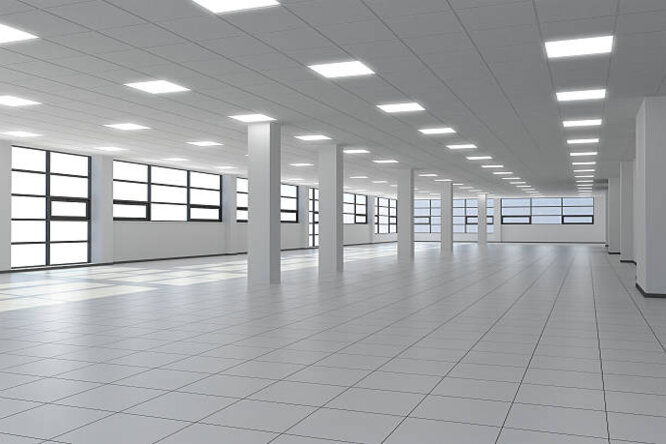
Conventional ceilings are the most common types of ceilings you will come across in most homes. They feature a flat, plain, or seamless surface that is made of mostly drywall or wood. You can use this type of ceiling for basically anywhere in the home.
Pros
- Lighting fixtures are relatively easy to fix with this type of ceiling
- Repair and replacement are easy
- Complements all types of interior designs
Cons
- Requires regular repair maintenance
- Because of the nature of the surface, it is prone to discoloration
2. Coffered Ceiling
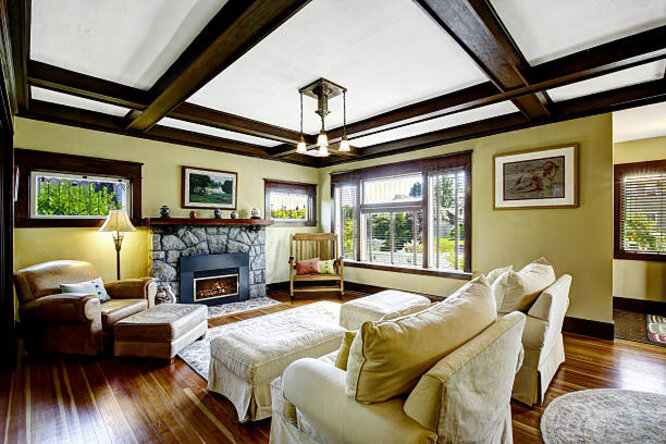
Coffered ceilings are common in high-end homes, libraries, churches, and hotels. They feature a combination of beams and inverted panels that cross each other, offering classic and luxurious aesthetics. This type of ceiling can be the focal point of the room so is best for dining rooms.
Pros
- Matches any type of home design
- Offers an elegant and sticking aesthetics
- Is the best type of ceiling to showcase artworks, paintings, or room decor
Cons
- Installation is not easy and must be done by a profession
- Very expensive
3. Cathedral Ceiling
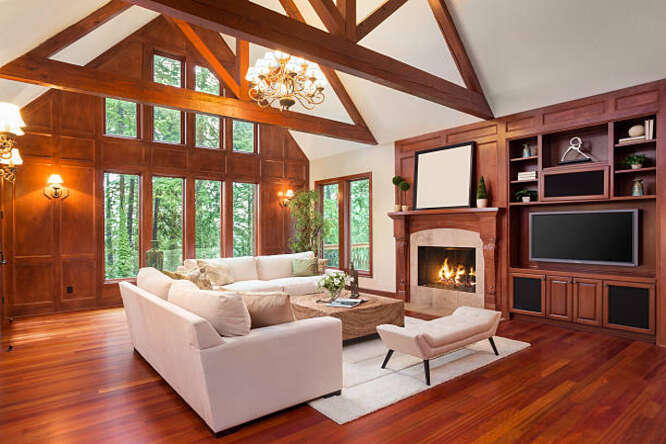
Cathedral ceilings, which are also referred to as vaulted ceilings are denoted by an inverted V shape (^). With the top of the ^ as the highest point and the sides sloping down. This luxurious type of ceiling is very pricey and is mostly used in large living rooms, dining rooms, and bedrooms.
Pros
- They allow more light into the room
- Vaulted ceilings provide more space in the room
Cons
- Very expensive
- Maintenance and repairs can be very costly
4. Tray Ceiling
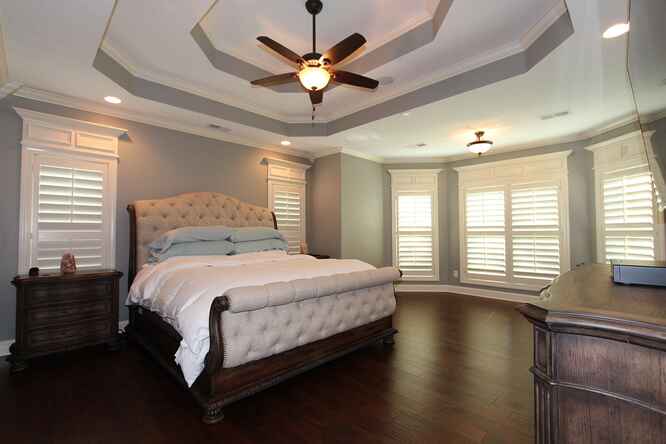
Tray ceilings feature a quick succession of varying heights receding upward into your ceiling and mimic the look of a tray, hence the name “tray ceiling”. They are made of veneer sheets or plywood panels that are nailed on top of each order, in an overlapping format.
Pros
- Very attractive
- Pairs nicely with various architectural styles
- Increases the height of the room
Cons
- The varying height makes it hard to paint
- The varying height makes it hard to clean
5. Shed Ceilings
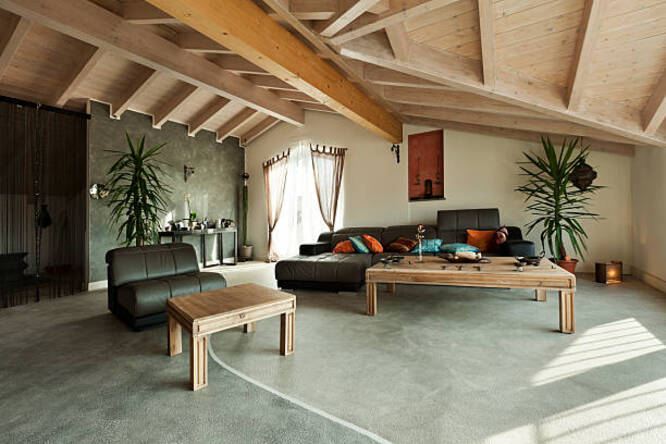
Shed ceilings or sloped ceilings are commonly seen in the top story of the house, more specifically, the attic or loft. It is one of the oldest forms of roofing because of its simplicity, flexibility, and cost-effectiveness. Which is one of the major reasons behind its success over the years.
Pros
- Very affordable
- Because of its slant nature, it is easy to install solar panels on top
- Adds value to your property
Cons
- Can drop low, making the room look smaller
- Some parts of the room might be darker than others
6. Suspended Ceiling
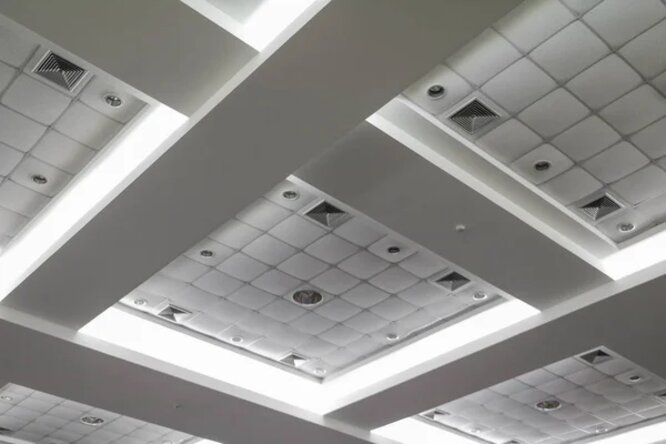
Suspended ceilings, also referred to as dropped ceilings are very popular in commercial buildings, offices, and retail spaces. This type of ceiling allows homeowners to conceal mechanical, electrical, plumbing, and lighting fixtures above the suspended ceiling.
Pros
- Easy installation
- Help conceal any building flaws such as wires, ductwork, and pipes
- Fairly affordable
Cons
- Not as durable as other types of ceilings as suspended ceilings may eventually deteriorate
- Reduces the overall height of the room by several inches
Different types of ceilings for both commercial and residential spaces by materials
After seeing various ceiling types by design, let’s look at the various ceiling types by materials.
1. Drywall
Drywall, also termed gypsum board, sheetrock, or wallboard is a very common ceiling material. It comprises different materials pressed together to form a large sheet. The sheet is then used to cover the ceiling and allowed to dry.
Pros
- Good insulator
- Fire resistant
- Available in multiple finishes (paint, wallpaper, etc.)
Cons
- Susceptible to damage
- The difficult installation has to be done by a professional
- Not as cheap as one would hope
2. Plaster of Paris (POP)
Plaster of Paris is a wet mixture of gypsum and limestone (sometimes other materials) trowelled and allowed to dry. It provides a sturdy, durable, and beautiful surface ready for painting. What’s more, the plaster of Paris can be molded or shaped into decorative patterns just like drywall.
Pros
- It has an extensive lifespan
- Very customizable
- Proper insulation, makes it a great fit for both warm and cold weather
Cons
- Installation is difficult
- Repair also tends to be difficult
- Susceptible to water damage
3. Wood
Wood is one material that is very versatile and easy to work with, this is why it happens to be a very good ceiling material. They are easy to install, repair, or install, while still giving your home a warmth and a rustic feel.
Pros
- It is cheap
- Extremely durable
- Increases the curb appeal as there are a variety of styles and patterns to choose from
- Lightweight
Cons
- Difficult to cut
- Difficult to maintain as it is a natural resource
- Risk of damage by mold, termites, and other pests
4. Metal
Metal ceiling tiles can be applied to virtually any room in your home. They are designed with plastic-coated surfaces in order to make the installation process easier. They also have a strict installation process, making them perfect for home energy efficiency.
Pros
- Easy installation
- Fire resistant
- They won’t rot
- Strong and durable
Cons
- Very expensive
- Must be coated to protect them from corrosion
5. Fiberglass
Fiberglass ceiling tiles are very common in commercial buildings but people also install them in their homes. It is environmentally friendly, lighter than wood, easy to install, affordable, etc. Who wouldn’t want a material with numerous benefits as fiberglass ceiling tile?
Pros
- Durable
- Sturdy
- Fire resistant
- Excellent for sound absorption
Cons
- The installation has to be done by a professional (not a DIY project)
- Installation may be costly
6. PVC
PVC or polyvinyl chloride ceilings are popular today because they cost less than many other ceiling materials available on the market today. They are lightweight, easy to install, and come in a variety of sleek designs to help give your home an electric or modern look.
Pros
- Very cost-effective compared to the other types of ceiling materials
- Installation is relatively easy
- Simple yet beautiful aesthetics
Cons
- Not subtle
- Repair and replacement tend to be difficult
FAQs
Is ceiling installation expensive?
To be honest, ceiling installation may be slightly on the high side since the installation is calculated per square foot. Other factors such as style, material, and labor can also influence the price.
Which ceiling material is most durable?
In terms of durability, metal ceilings do not crack or warp over time, making them the most durable.
Which ceiling material is cheaper?
PVC or polyvinyl chloride ceiling panel is one of the most cost-effective options.
Which ceiling design is best for the bedroom?
Tray ceilings and coffered ceilings are quite popular options for bedroom ceilings.
Which ceiling material is best for the bathroom?
Water-resistant fiberglass and drywall are two of the best materials to consider for your bathroom ceiling.
Wrapping things up – Types of ceilings for your home
So there you have it, I have covered some of the most common ceiling types designs, and materials. Along with that, here are a few things to consider when trying to decide which ceiling material and design to use for your home.
You do not have to go out of your price range to get the ceiling you want, this is why working with a professional is advised. With other materials, you can achieve ceiling styles that can get close to the look you want for less. Also, you can start the project small, have a small room done, and see how it looks. Small rooms are easier to change in case you decide you do not want that type of ceiling all over your home.
Ceiling installation might be an expensive and complex task often requiring the service of a skilled professional. So, don’t be afraid to get in touch with a contractor who can properly install them. Remember, our aim is to ensure your visions come into reality.
Thanks for reading.